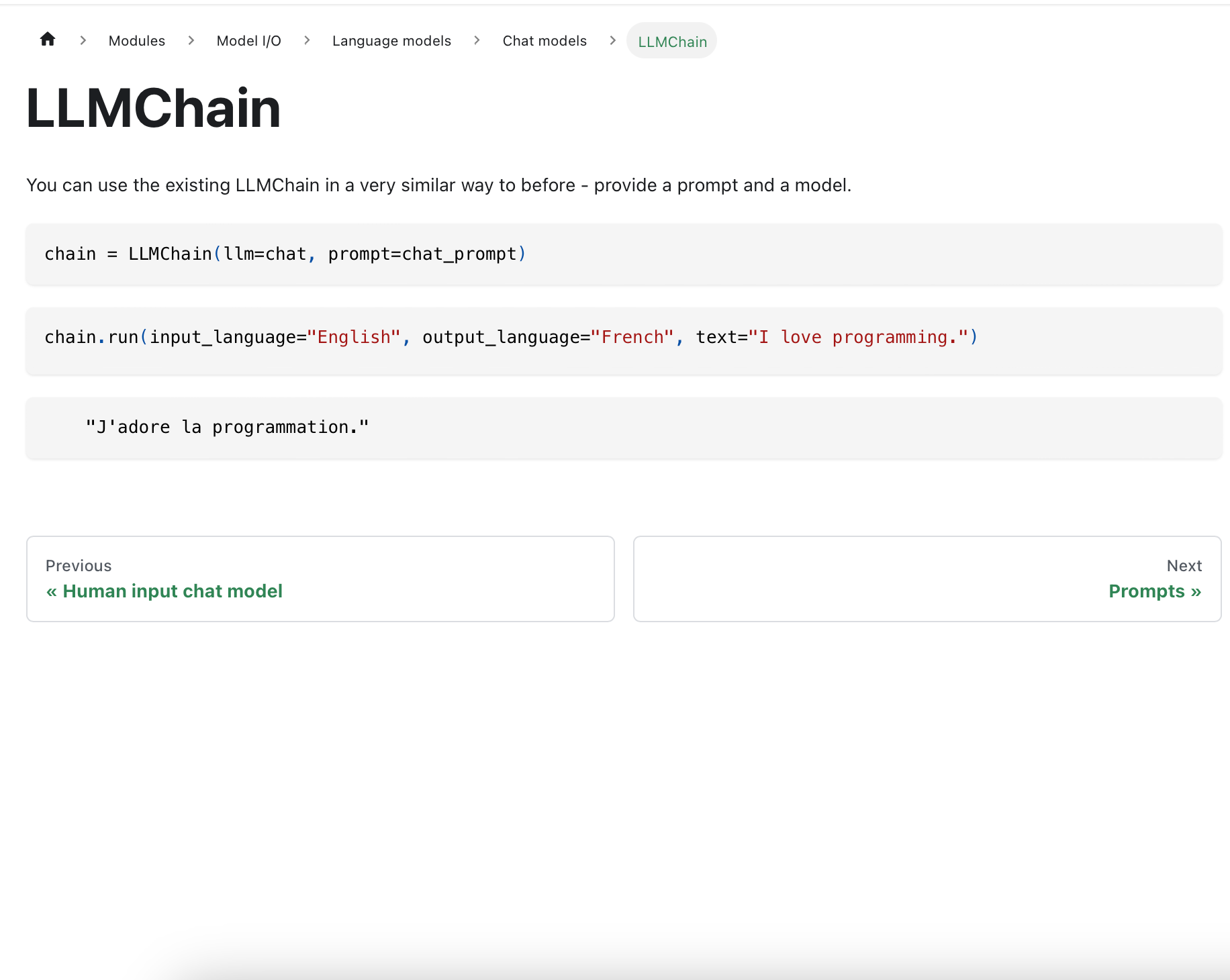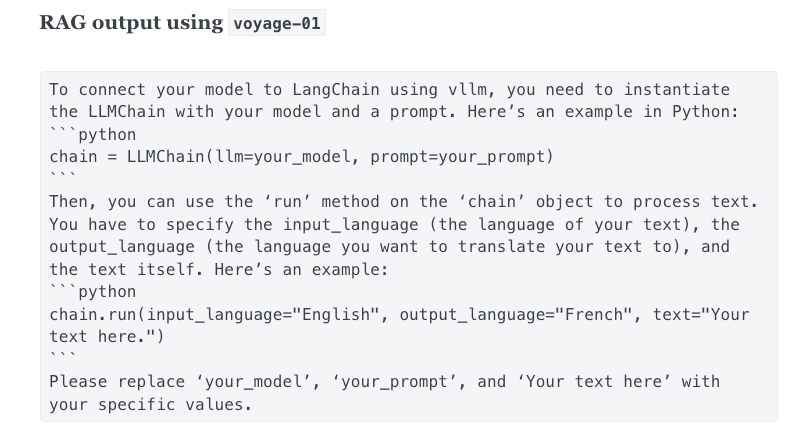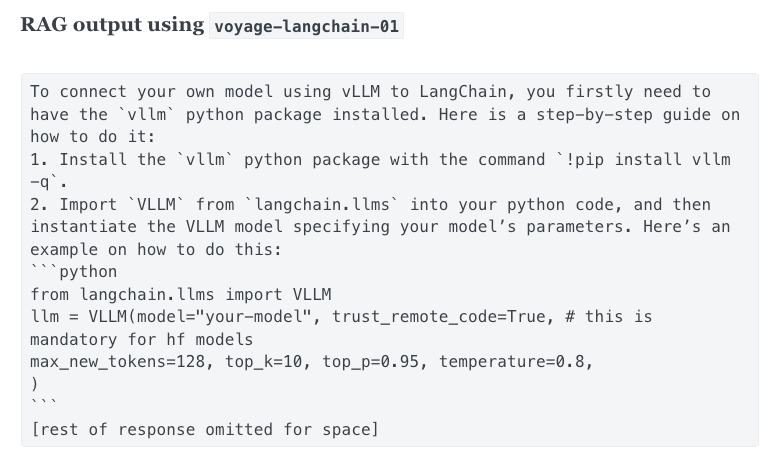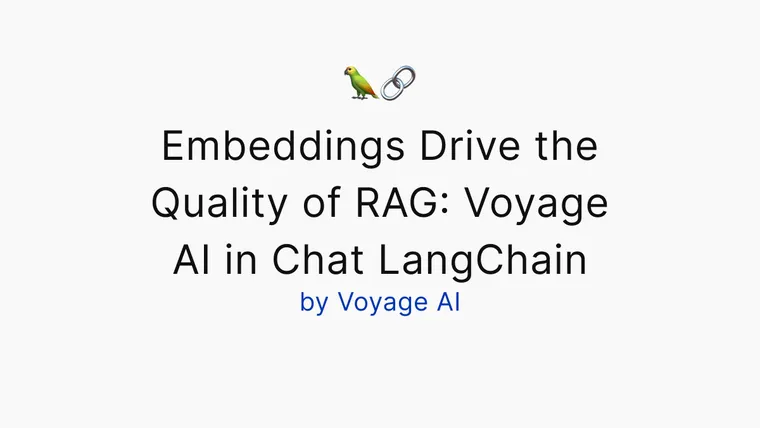Editor's Note: This post was written by the Voyage AI team.
This post demonstrates that the choice of embedding models significantly impacts the overall quality of a chatbot based on Retrieval-Augmented Generation (RAG). We focus on the case of Chat LangChain, the LangChain chatbot for answering questions about LangChain documentation, which currently uses fine-tuned Voyage embeddings in production. We finish by showing how to access general Voyage embedding models via LangChain.
Brief background on RAG, retrieval system, and embeddings
Retrieval-augmented generation, commonly called RAG, is a powerful design pattern for chatbots where a retrieval system fetches validated sources/documents that are pertinent to the query, in real-time, and inputs them to a generative model (e.g., GPT-4) to generate a response. With high-quality retrieved data, RAG can ensure that generated responses are not just intelligent, but also contextually accurate and informed.
Modern retrieval system are empowered by semantic search using dense-vector representations of the data. Embedding models, which are neural nets models, transform the queries and documents into vectors, which are called embeddings. Then, the documents whose embeddings are closest to the embedding of the query are retrieved. The quality of the retrieval is thus solely decided by how the data are represented as vectors; vice versa, the effectiveness of embedding models is evaluated based on their accuracy in retrieving relevant information.
Please check out this introduction post to RAG for more details.

Evaluating the effect of embeddings in the RAG stack
Methodology. RAG has two main AI components, embedding models and generative models. We ablate the effect of embedding models by keeping the generative model component to be the state-of-the-art model, GPT-4. We measure two metrics, (1) the retrieval quality, which is a modular evaluation of embedding models, and (2) the end-to-end quality of the response of the RAG. We will show that retrieval quality directly affects end-to-end response quality.
Evaluation scenarios. In this post, we focus on the scenario of the Chat LangChain bot that answers questions about LangChain documentation. The open-source chatbot uses a RAG stack with a pool of 6,522 documents sourced directly from the LangChain docs. From the partnership with LangChain, we obtained a collection of 50 pairs of queries and corresponding gold standard answers, which are the main dataset for evaluating the response quality.
Models. We consider three embedding models, OpenAI’s industry-leading embedding model text-embedding-ada-002 , Voyage’s generalist model voyage-01 , and an enhanced version fine-tuned on LangChain docs , voyage-langchain-01.
Measuring response quality. To evaluate the response’s quality, we compare the semantic similarity between the generated responses and the gold standard responses by asking GPT-4 to evaluate the similarity with a score out of 10. A score of 1 indicates that the generated answer is incorrect and bears no relevance to the gold standard answer, while a score of 10 signifies a perfect alignment with the gold standard answer.
Measuring retrieval quality. For the 50 queries, we manually curate the gold-standard documents that are most relavent to the queries. We retrieve 10 documents for each queries, and use the standard NDCG@10 metric to calculate the relevance of the retrieve docs to the gold-stand document.
Results. The table below shows that voyage-01 surpasses OpenAI’s text-embedding-ada-002 in both the retrieval quality and response quality. Furthermore, voyage-langchain-01, which was specifically fine-tuned on LangChain documents, has the highest retrieval and response quality. The data suggest that indeed the quality of the final response is highly correlated with the retrieval quality, and voyage-01 and voyage-langchain-01 improve the final response’s quality by improving the retrieval quality.
| Model Name | Response quality(1-10) ↑ | Retrieval quality ↑ |
|---|---|---|
Voyage (voyage-langchain-01) | 6.25 | 52.40 |
Voyage ( | 5.08 | 47.55 |
OpenAI (text-embedding-ada-002) | 4.34 | 45.81 |
Demonstrating examples
We support the quantitive results above by showcasing a few intuitive examples where more accurate retrieval with Voyage’s embeddings enables more accurate responses.
Example 1: voyage-01 vs text-embedding-ada-002
Query: “What is html2texttransformer? Does it omit urls?”
Given the query above, voyage-01 (left) fetches the correct document, the detailed description of the html2texttransformer function, whereas text-embedding-ada-002 (right) retrieves a less relavent document, the documentation of html2text which contains html2texttransformer as a method. The latter document does contain the string html2texttransformer but only in an exemplar code block.


Left: Top-1 doc retrieved by voyage-01. Right: Top-1 doc retrieved by text-embedding-ada-002.
Consequently, the response generated by RAG using the voyage-01 (left) is accurate, whereas the response with text-embedding-ada-002 (right) confuses html2texttransformer with the class that contains it.


Example 2: voyage-01 vs voyage-langchain-01
The fine-tuned model voyage-langchain-01 has a superior retrieval quality and response quality than voyage-01. The examples below demonstrate how voyage-langchain-01 can fetch documents with more pertinent information given the query below.
Query: “I’m running my own model using vllm. How do I connect it to LangChain?”
As we can see below, voyage-01 (left) doesn’t give a document that is relevant to vLLM, whereas voyage-langchain-01 (right) retrieves the correct document. Here the reason is that vLLM is a highly specialized concept that a generalist embedding model is difficult to grasp; but a fine-tuned model has seen the LangChain documentation and thus can catch up with the terminology and concept.


Left: Top-1 doc retrieved by voyage-01. Right: Top-1 doc retrieved by voyage-langchain-01.
Not surprisingly, the RAG with voyage-langchain-01 (right) accurately answers the question. On the other hand, without retrieving the correct document, RAG with voyage-01 (left) hallucinates an answer.


Using Voyage in LangChain
As of langchain >= 0.0.327, Voyage is integrated into the LangChain Python package, allowing anyone to access the voyage-01 model for their own applications.
You can get a Voyage API key here, which should be set as an environment variable:
export VOYAGE_API_KEY="..."Install the latest version of LangChain:
pip install -U langchainAnd you can start using VoyageEmbeddings . Here's a simple example of how to use Voyage to power KNN retrieval:
from langchain.embeddings import VoyageEmbeddings
from langchain.retrievers import KNNRetriever
texts = [
"Caching embeddings enables the storage or temporary caching of embeddings, eliminating the necessity to recompute them each time.",
"The agent executor is the runtime for an agent. This is what actually calls the agent and executes the actions it chooses",
"A Runnable represents a generic unit of work that can be invoked, batched, streamed, and/or transformed."
]
embeddings = VoyageEmbeddings(model="voyage-01", batch_size=8)
retriever = KNNRetriever.from_texts(texts, embeddings, k=1)
result = retriever.get_relevant_documents(
"How do I build an agent?"
)
print(result[0].page_content)The agent executor is the runtime for an agent. This is what actually calls the agent and executes the actions it chooses
You can find the full LangChain integration docs here and the Voyage docs here.
Takeaways
The retrieval quality of the embedding models is highly correlated with the quality of the final responses — to make your RAG more successful, you should consider improving your embeddings! Try Voyage embeddings voyage-01 or contact us for early access to the fine-tuned models at contact@voyageai.com. Follow up on twitter and/or linkedin for more updates!

